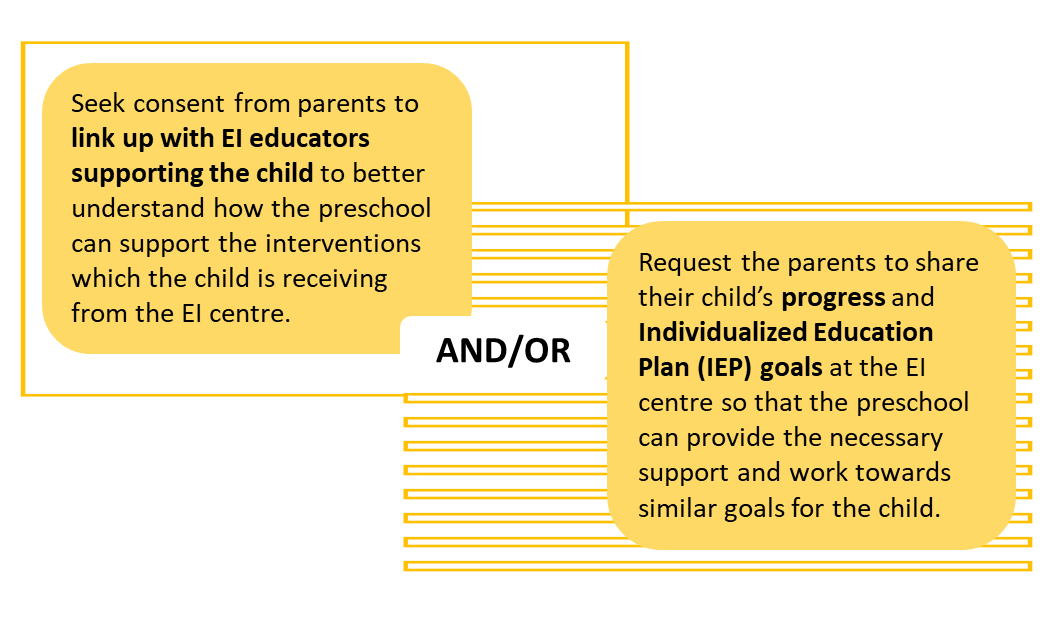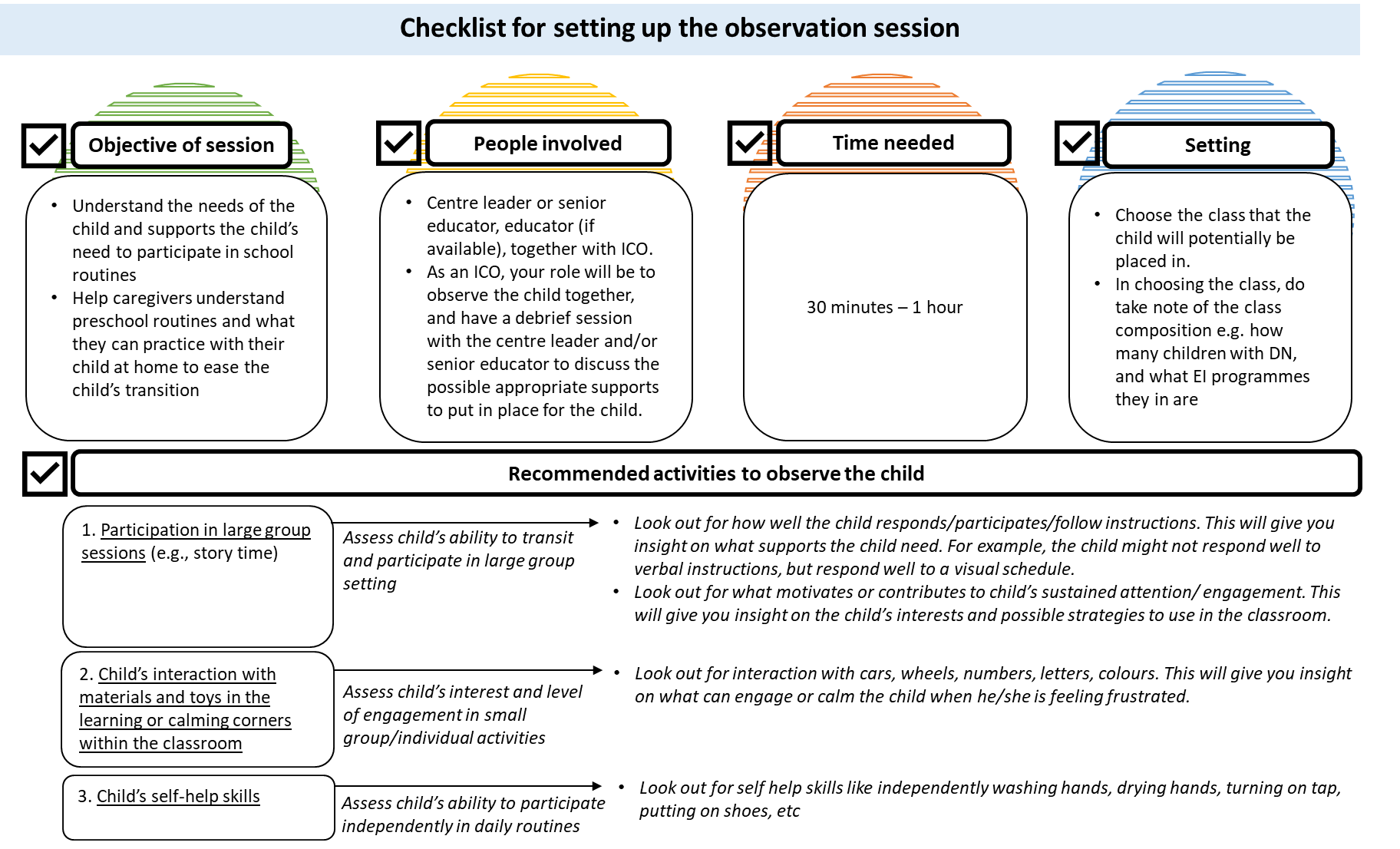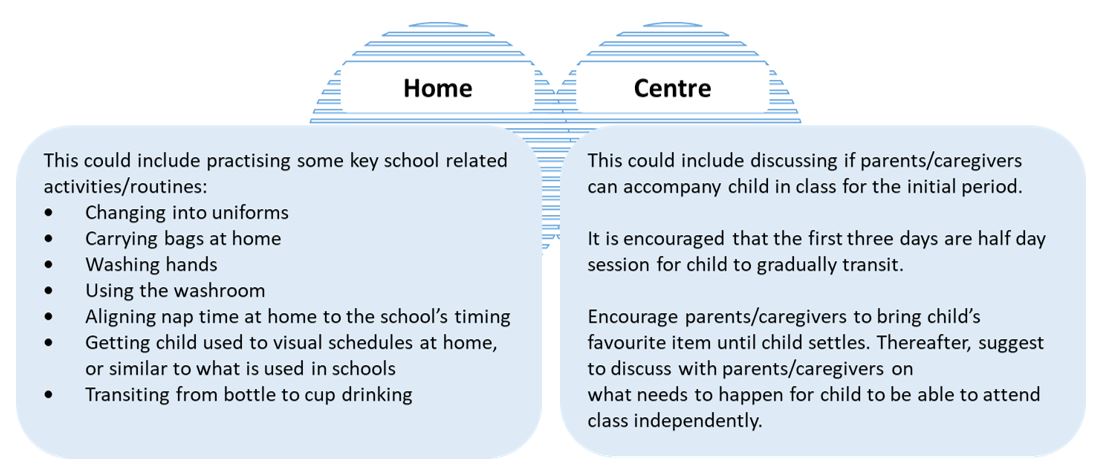1: Introduction to Enrolment of children with developmental needs (DN)
As an ICO, you are encouraged to work with your centre leader to establish centre processes for the child’s enrolment. You may not have to set up new processes as your centre may already have processes in place for general enrolment of children at your centre. You can add on to those existing workflows where relevant.
The objective of this preparation process for the centre is to ensure the preschool has a holistic understanding of the child – from people who know the child in other settings and have first hand information on the child’s behaviour and needs.
There are three recommended steps:
- 1) Request for background information of child – this can include medical report, information from EI professionals, caregivers’ observations of child
- 2) Conduct observation of child’s behaviour in preschool setting
- 3) Preparing for enrolment
It is important to have a holistic understanding of the child’s needs (e.g. from different people who interact with the child, across various settings such as the EI centre or at home) so that your centre can make an informed assessment whether the child can be adequately support in your centre. The following are some of the key information sources:
(a) Paediatrician’s Diagnosis or Medical Report
To better understand the child’s developmental needs, it will be best to have access to the child’s medical report. Caregivers should have this report if the child has been to a paediatrician or been referred and/or placed in an EI programme.
You may request information on any diagnosis or medical report from the parents. Do be mindful to broach the topic sensitively, as parents may have reservations about sharing details of the child’s needs and how the information may be interpreted
and used by the centre.
The medical report will provide you with information about the child’s diagnosis (if any), assessment of the child’s level of functioning across domains, and recommended support or follow up for the child.
When interpreting the report, it is recommended that you seek guidance from professionals trained in DN (e.g., psychologists, Learning Support Educators) so that they can advise on what is known about the child’s development based on the assessment
and how to make sense of the information provided within the report.
 |
If the family or caregiver is unwilling/unable to provide the diagnosis report, discuss the child’s strengths and difficulties instead. Understanding the child better will help you plan your activities and use the most appropriate prompts or strategies to engage them. If the caregiver has not brought the child for assessment with a paediatrician, you can refer to Domain 3 for more information on referring the child for assessment and services. |
(b) Information by EI professionals
If the child is currently enrolled in an EI centre, you can:

Talking with the EI educators could help you identify strategies that can facilitate the child’s transition. You may want to find out about the child’s Individualised Educational Plan (IEP) and goals set, child’s progress and strategies/approaches that worked well with the child. The IEP will provide information about assessment outcomes, intervention needs as well as the review of the child’s progress during the period of support.
In some cases, the child may be on the waitlist for EI services. If this happens, you can find out the estimated wait time from the parents and discuss with your centre leader and EC colleague how to provide basic support for the child during the waiting period. You can also check in regularly with parents for updates from the EI centres.
Beside working closely with the parents or caregivers, you can also request for child’s parents or caregivers to link you and child’s EC educator with the EI centre that the child is waitlisted at. This could help you find out about pertinent information from the child’s intake screening and indication of the type of support child may need.
(c) Caregivers’ observations
(i) Child’s ability to participate in routines
To ensure that the child can cope with the preschool’s routines, it is important to understand from family members, caregivers or EI educator on the child’s ability to participate in the routines at home. You can ask about the following questions:
- 1. Is your child able to feed himself/herself?/What is his/her favourite food?
- 2. Is your child able to go to the toilet independently ? (To change question appropriately)
- 3. How does your child transit to bedtime every night? Is there an existing routine?
(ii) Child’s motivations
Communicating with a child with DN can be challenging. Therefore, do encourage family members, caregivers to share the common motivators used at home or in other settings. This information can help ease the child into slowly opening up to his or her new friends and EC educators in the preschool. You can ask the following questions:
- 1. What is your child’s current favourite song/toy/show?
- 2. What does your child like to do at home?
- 3. How long can he or she keeps to the activities?
- 4. Does your child play more on his/her own or with others? What type of play does your child enjoy the most?
- 5. What are situations that will upset or frustrate your child?
It is useful to observe the child in the preschool setting to find out more about the needs of the child, and plan for the types of support the child requires to thrive in the preschool. Your preschool may already conduct pre-enrolment visits or open house sessions for parents, so it will be useful to use those sessions to observe how the child interacts and behaves in the preschool setting.
If your preschool doesn’t already have such sessions, you may want to discuss with your centre leader about conducting such session for the parents and child before enrolment.

 |
For children who are not ready to participate in any of the above, recommend for parent/caregiver to accompany child closely. This also serves as opportunity for centre to share strategies with parent/caregiver. |
a) Preparing the centre
In the debrief session after the observation, it will be important to plan for the supports that need to be in place. You can plan this with your centre leader and the
EC educator based on two key features of inclusion (DEC, NAYEC, 2009):
- 1. Facilitate Access – this is providing access to a wide range of learning opportunities, activities, setting and environments. Some examples include:
- Accessibility to physical space: Walkways and ramps to facilitate getting around centre, toilet fixtures
- Equipment and furniture: Seating supports that cater to children with varying needs, tables/chairs of customisable height, mobility aids
- Materials:
- If you have a book to tell a story, you may also ensure that you have props that support the different senses such as puppet, matching cut-outs, figurine, head gear, etc;
- If you are doing a writing activity, you may consider beyond paper and pen to include floor and chalk, finger paint, play dough, sand writing and others.
- 2. Facilitate Participation in centre and class. Other than facilitating access, the intent of this is to ensure engagement. Some examples include:
- Implement visual schedule in classroom – visual supports are useful to introduce routines and expectations in a new environment and facilitate participation. Children will feel less anxious, and can be empowered to take responsibility and act accordingly;
- Social stories. This can help children understand and navigate transitions, reduce their anxiety and promote a sense of familiarity with the new environment;
- Put in place a buddy system for all children. This allows for peer support, membership and empower all children to act responsibly.
- 3. Facilitate Supports at centre level to support inclusive practices. Some examples include professional development, opportunities for collaboration and cross-learning, pooling of resources (e.g., manpower deployment, presence of shadow teacher)
 |
If the child is known to the EI centres, you may also want to discuss with the EI professional on what can be helpful to facilitate participation and access for the child. |
Facilitating the child’s transition
While the focus is on gathering information on the child, do remember to use this opportunity to build a good working relationship with the child’s
parents. Empathy and understanding will reassure the families. While the preschool has its priorities, do note that it is important for parents to feel that their values and priorities are heard and respected. It will be useful to work closely
with parents/caregivers on facilitating child’s transition into school and ease child into school routines:

For the follow up after enrolment and supporting transition of child within the preschools e.g. change of class after graduation, do refer to Domain 4 on supporting child’s transition to new class/school environment.
